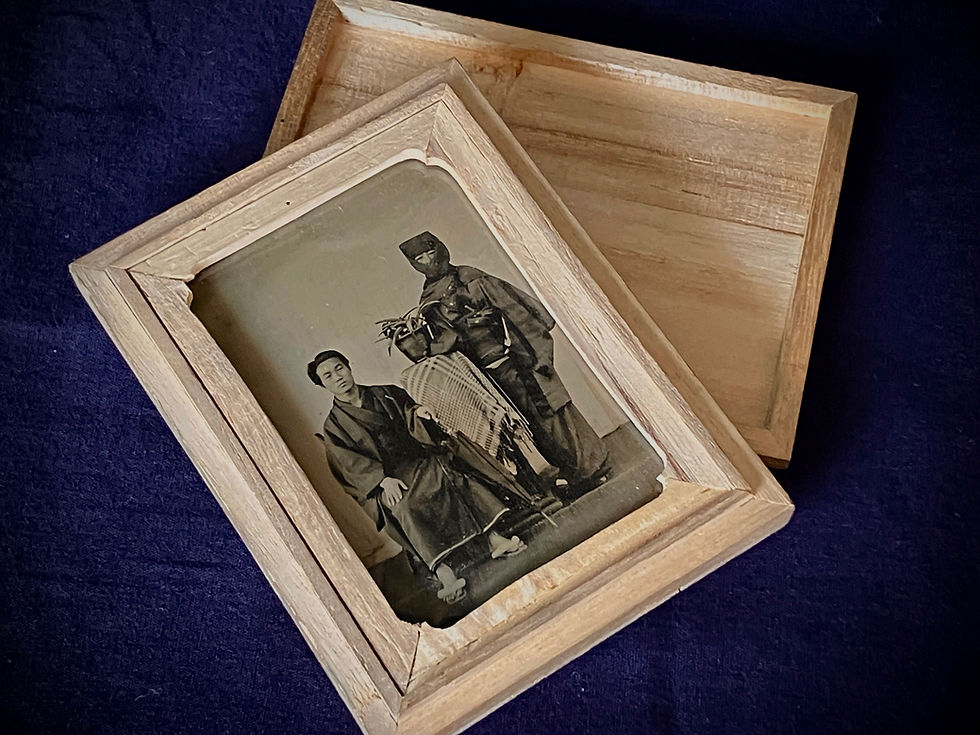The Essence of Photography: Rediscovering Aura Through Wet Plate Photography
- esfahanchaihane
- Jun 27
- 3 min read
Why Are There So Few Photos That Truly Stay With Us?

These days, we take countless photos with our smartphones. A trip might result in hundreds of pictures, and we may document our children growing up almost daily.
And yet, when we stop to think about it―choosing just one photo that truly stays in our heart is surprisingly difficult.
Despite the sheer number of photos, the ones that remain in our memory seem to be fewer.
Why does this happen?
To explore this question, I’d like to turn to the words of a certain thinker who found deep value in “a once-in-a-lifetime experience.”

Who Was Benjamin? And What Is “Aura”?
Walter Benjamin was a German thinker active in the early 20th century. One of his most well-known concepts is the idea of aura.
Aura refers to the unique atmosphere or presence that can only be felt “here and now.”
for example,
The heavy air you feel when standing before the Mona Lisa at the Louvre.
The smell of the paper and the distinct handwriting when you reread a heartfelt letter from someone dear.
The breathless stillness in a concert hall during a live performance.
These are all experiences marked by a sense of singularity―moments that cannot be reproduced or replaced by copies.
That is what we call aura.
What Does It Mean When We Say That Aura Is Lost in the Age of Reproduction?
Benjamin argued that as technology advances and art becomes easily reproducible, its aura inevitably fades.
Take, for example, masterpieces like the Mona Lisa or Vermeer’s paintings displayed in museums. Today, they can be endlessly reproduced as posters, in art books, or catalogs―making them something that anyone can “own.” With each copy, their unique presence, their special atmosphere, seems to lose its power.
Photography and video face a similar reality.
Images taken with a smartphone are uploaded to the cloud with a single tap, spread instantly across social media, and then “optimized” by AI to look more appealing.
Yet through this process, it becomes increasingly unclear whose memory the image actually belongs to.
Wet Plate Photography and Irreversibility: Why the Fact That You Can’t “Redo” It Matters
Wet plate photography (the collodion process) is an early photographic technique invented in the 19th century.
Its defining feature is that everything―exposure, development―must be completed while the plate is still wet.
The process begins by coating a glass plate with a chemical called collodion, then sensitizing it in a silver bath inside a darkroom. From there, the clock starts ticking. The plate must be exposed and developed before it dries.
If a single step goes wrong, that one image is lost forever.

For the photographer, it’s a one-shot decision―composition, exposure, and focus must all be precisely determined in the moment.
And for the person being photographed, the experience naturally encourages a straightened posture and a quiet, intentional presence in front of the camera.
Then, as the plate is submerged in the developer, the image slowly begins to emerge.
That moment carries a gravity unlike any ordinary portrait―serious, unspoken, and quietly profound.
Wet Plate Photography May Be an Act of Reclaiming Aura
Wet plate photography possesses a unique texture that sets it apart from other photographic methods.
But it’s not just about how it looks.

The temperature and humidity of the day
The timing of the shoot and the tension in the atmosphere
The lingering echoes of words exchanged between photographer and subject
--All of these things leave traces on the glass as chemical reactions.
I believe this is what we call "texture in the medium of photography."
It’s reminiscent of how the invention of photography pushed painting away from realism and toward its own medium-specific qualities―brushstrokes, surface, and texture.
In modern digital photography, images are infinitely smooth and free of grain. What matters is simply what is shown.
Wet plate photography, on the other hand, reveals how something was captured―even before the viewer even begins to ask what they are looking at.
Perhaps that’s what creates the subtle friction we feel when looking at a wet plate image.
And perhaps, that very friction is what we recognize as aura.
Capturing You―Just As You Are, in This Irreplaceable Moment
Wet plate photography doesn’t allow you to take dozens of shots in quick succession.
But in that one image, the weight of a moment that can never be repeated is preserved.
Precisely because it can’t be redone, there’s a sense of intention―and beauty―that emerges.
In an age overflowing with digital images, perhaps wet plate photography is a way of reclaiming the significance once held by “just one photograph.”
To take a wet plate portrait―it may not be about the future of photography,
but about experiencing its essence.

About the technique of wet plate photography → What is wet plate photography?
Learn more about wet plates → Wet Plate Journal (blog)
See the actual work → Gallery
Want to try photography or experience it? → Fees/Workshops



